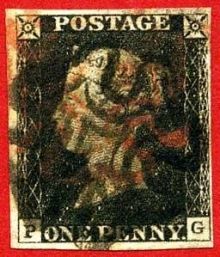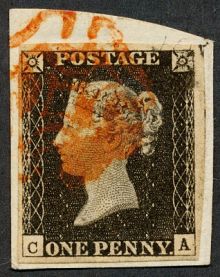GB Coloured Maltese Crosses
In 1840 certain coloured inks were used to cancel the stamps instead of the standard Red (subsequent Black) cancellation inks.
Return to the Distinctive Maltese Cross Page
Red
In 1840 Rowland Hill conducted many experiments in the cancellation of the stamps to be introduced. The initial results of which led him to instruct the use of Red ink for cancellation. A standard 'recipe' was sent out for postmasters to make up the necessary ink to be used. However as can be seen in the stamps this human factor led to many varying shades of red ink. Time and environmental factors can also influence what we see today, so collectors should be wary of misleading descriptions of shades. Post Office Circular dated April 25th, 1840, contains the following :
" Directions for preparing the Red Stamping Composition. 1lb. Printer's red ink. 1 pint Linseed Oil. Half-pint of the droppings of Sweet Oil. To be well mixed."
Whilst Red ink was meant to have stopped being used from February 1841 some offices continued using it for an extended period. Billericay is known to have used it on Christmas Day, 1841. Whilst Dalry has been seen on covers dated June 1841. Late red MX use has also been noted on covers from Belfast, Southport and Adrossan to name a few.
Black
Later in August of 1840, it was decided that the red ink on the black 1d was not satisfactory, cancels were often faint leading to re-use of stamps. Trials started to look at other possibilities. It was decided that a Red printed stamp would be more suitable with the standard Black ink that every office used. Printing of the Red 1d stamps commenced late December 1840 from plates that were currently on the presses to build up a stock. Post Office memo's were sent out showing the new stamps in red and the instruction to use the Black ink to cancel. 1d Red stamps were on sale from February 1841. Red MX cancels on Red stamps exist as the offices used up their ink supplies. It is also possible to obtain stamps (see below) with both a red and a black cross. Observant postal clerks who saw the red ink still being used over-cancelled the red ink with black in order to 'correctly' cancel the stamp.
 1841 1d Red Plate 26 with Dublin Type 2a Showing the Dublin Break. |
 1840 1d Black Plate 4 with Manchester Fishtails Maltese Cross (LG) | ||
Black & Red
 1840 1d Black Plate 9 with Red Market Bosworth Hot-Cross Bun Cancel, overcancelled by a Black Maltese Cross |
Blue
 1841 1d Red Plate with Blue Truro Maltese Cross |
 The Blue MX of Mountrath sent to Rathdowney 20th October 1843 One of only two Blue cross examples known from this town. SG8 letter position 'QB' plate 35. |
Yellow
Considered to be the rarest colour of Maltese Cross.
This stamp was sold by Corbitts in their October 2018 auction. Since that time and December 2020, someone decided to cut the right hand margin off and try and make an enhanced top and bottom margin, but did a very very poor job of it.
Magenta & Ruby (shades)
Magenta crosses appear in varying shades and are know on covers from Glasgow, Burton-on-Trent, Preston, Newtownmountkennedy. The more Purple Magenta shades are known from; Aberdeen, Bogroy, Burton-on-Trent (covers of June 1840), Fintry, Glasgow (covers of April 1841), Manchester, Milton of Campsie (in March and April of 1841). Newry (October 1840), Renfrew (June 1840) and Wexford (during December 1840). The Ruby Shade has been attributed to Aberdeen.
White
No longer catalogued as a colour, the white crosses are now believed to be reduced states of the cancelling inks used. When re-oxidised with hydrogen peroxide they return to their original red/pink colouration. Most examples show some degree of red/pink in them. Often attributed to Cirencester and Cheltenham..
 1840 2d Blue Plate 1 with White Maltese Cross usually attributed to Cirencester |
 1840 1d Black with White Maltese Cross usually attributed to Cirencester |
Orange
A number of offices had a shade of Orange ink in use, most noteably Liverpool for a period.
Brown
Pink





























